
views
Part Removal
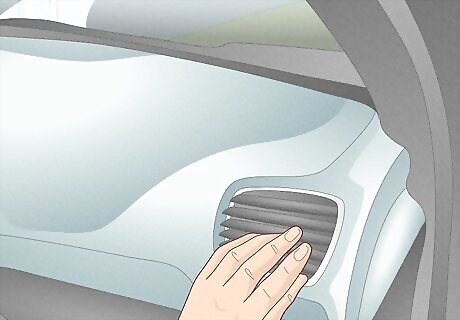
Remove dashboard parts, if desired, to paint, protect, or replace them. If you’re going to paint smaller trim pieces, like the ones around the stereo and air vents, it’s usually easier if you remove them from the car. Or, if you specifically don’t want to paint them, the easiest way to protect them is typically to take them out. This is also a good time to replace damaged or worn-out trim pieces, which also requires you to remove the old parts first. Taking out removable dashboard parts to paint separately reduces—but definitely doesn’t eliminate—the taping and masking you’ll need to do before painting the dashboard.
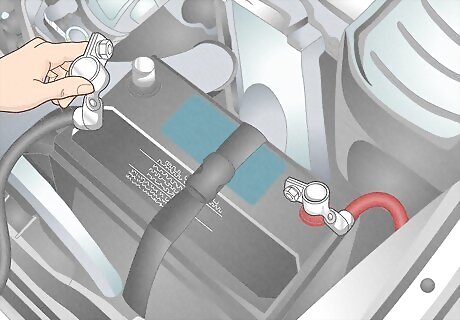
Disconnect the car battery before removing any dashboard parts. Put on safety glasses as a precaution, and make sure the car’s ignition is off. If there are plastic caps covering the negative (-) and positive (+) terminals, lift up the negative terminal’s cap. Loosen the nut that secures the cable to the terminal with a wrench, then move the cable well clear of the battery and any metal—lay the end of the cable on a clean towel if needed. You may be tempted to skip this step, but it’s well worth the minimal effort. There is plenty of wiring behind the dashboard parts you intend to remove.
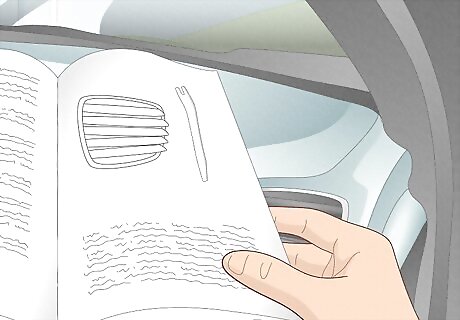
Check your owner’s manual for specific guidance on removing trim pieces. Your car’s dashboard parts will probably come out easily with nothing more than a screwdriver and a set of auto trim removal tools. But you definitely don’t want to break any of the parts you plan to paint, so take the time to consult your owner’s manual. You should find a section dedicated to removing trim parts correctly. If you don’t have the owner’s manual, check the automaker’s website for an online version.
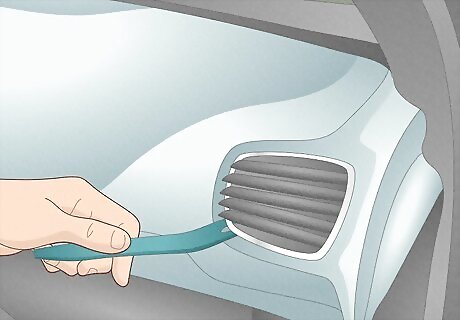
Use trim removal tools or a screwdriver to pop out any snap-in dashboard parts. Many of your dashboard’s removable parts simply snap in and out of place. If you insert the tip of a flat-head screwdriver into the seam at the edge of a part and apply minimal lever force, it should pop right out. That said, you’re less likely to cause damage if you buy a set of auto trim removal tools online or at an auto parts store—they’re made specifically for this task. Unlike a screwdriver, trim removal tools have slightly curved and forked tips like a crowbar. Simply insert the tool’s curved tip under the edge of a panel and use a lever action to pop it free. If a part doesn’t pop out with minimal force, check the owner’s manual again to make sure you’re removing the part the right way—it may have a hidden screw holding it in place!
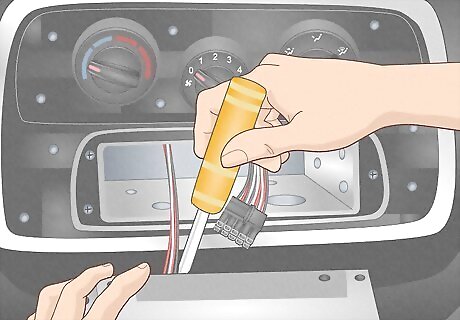
Use a screwdriver to disconnect any wiring or screwed-in dashboard pieces. Some dashboard parts are held in place with screws, so simply remove the screws by turning them counterclockwise with a screwdriver. Pull out the freed parts and be sure to save the screws for re-installation later. Use your screwdriver to also disconnect any wiring attached to the parts you remove. Either loosen (and save) the screws that hold the wiring harness in place on the backside of a part, or press in on the tab that releases the harness. As a reminder, be sure to consult your owner’s manual for the best results.
Dashboard Prep
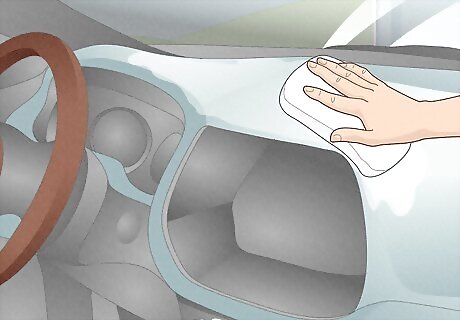
Wash what you plan to paint with water and a bit of dish soap. Lightly dampen a clean cloth, using warm water with a little squirt of dish soap mixed in. Wipe down all the dashboard components—whether removed or still in place—and let them air dry. If you’ve purchased replacement dashboard parts that you want to paint before installing, clean them the same way. The goal here is to remove all surface dirt and debris.
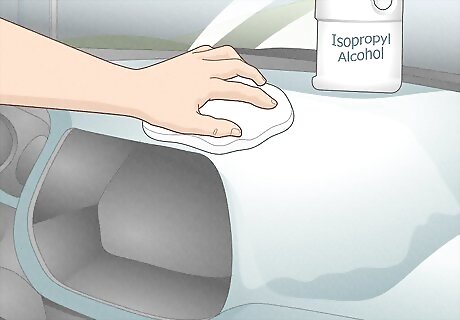
Wipe down the washed areas with isopropyl alcohol. Once all the components you washed with dish soap and water have dried, lightly moisten a microfiber cloth with isopropyl alcohol and wipe them again. Wiping with isopropyl alcohol gets rid of oily residues, such as those left behind by fingerprints. Isopropyl alcohol (rubbing alcohol) is widely available at pharmacies, grocery stores, and general retail stores. Your paint job will look better and be more durable if you complete both parts of the cleaning process—soapy water and isopropyl alcohol.
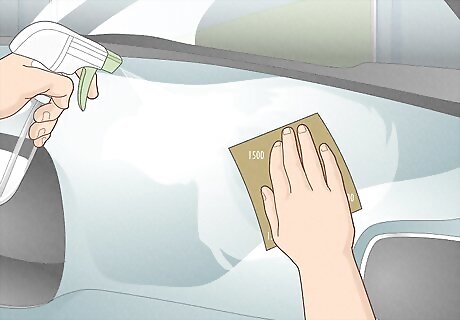
Mist the dashboard parts with water and sand them with 1500-grit paper. Use a small spray bottle to lightly mist the area you’re sanding. Sand in a circular motion and use very light pressure—press down just enough to keep the sandpaper from slipping out of place. Once everything is dry, wipe up all the sanding dust with one or more tack cloths. 1500-grit sandpaper is an ultra-fine grit. The goal here is just to very lightly rough up the surface to help the paint adhere better. Make sure to use the tack cloth! Wipe off all the sanding dust before proceeding.
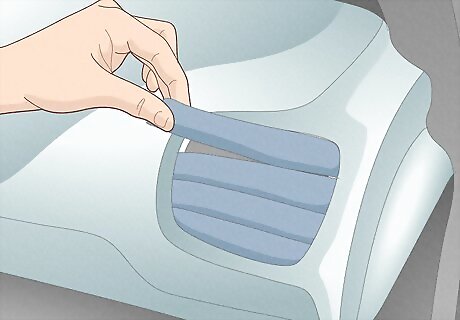
Cover items like vents and knobs with painter’s tape to protect them. Completely mask any of the smaller parts you don’t want to paint by using multiple strips of tape. Press the tape down firmly to ensure complete adhesion and clean lines. Likewise, to separate 2 parts of the dashboard—one that you want to paint, one that you don’t—run the tape against and into the seam between the 2 parts, smoothing the tape down firmly. Make sure the applied painter’s tape has full adhesion and no wrinkles. Otherwise, the spray paint may bleed underneath the tape.
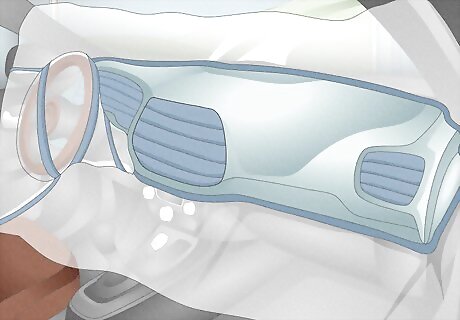
Use tape, plastic, and paper to protect the windshield, seats, steering wheel, etc. For example, put a plastic bag over the steering wheel and steering column, then run a strip of painter’s tape all the way around the base of the steering column. Tape up crafting paper or butcher paper to mask the windshield, and tape down paper or plastic to protect the front seats, floorboards, and so on. A good rule of thumb is to cover everything in the car that you don’t want to paint and that’s within a minimum of 3 ft (91 cm) of the dashboard. Spray paint can end up far from where you intend it to go, so be aggressive when it comes to taping and covering your car interior. A little more work now can save a lot of hassle later!
Primer
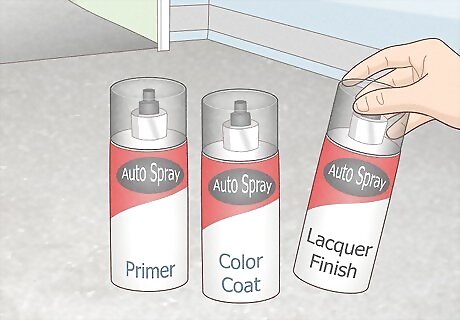
Buy spray cans of high-quality auto primer, color coat, and lacquer finish. Shop for your spray primer, color coat paint, and lacquer at a well-regarded auto paint retailer. Work with a knowledgeable sales associate to get the best products for your car and its condition. Choose one or more color coats that match the original color(s) of your dashboard, or try something completely new—the painting process is the same either way. You may need 2 types of primer, but they work the same way. Get a “filler primer” if your rigid plastic dashboard components are scratched up—it will help to conceal the scratches. Choose an “adhesion promoting primer” for any flexible plastic components—your main dashboard area may have a slightly supple vinyl finish, for example. Adhesion promoter can also be used on rigid plastic, but it won’t cover up scratches very well. Don’t use filler primer on flexible plastic parts—it will crack, split, and flake off.
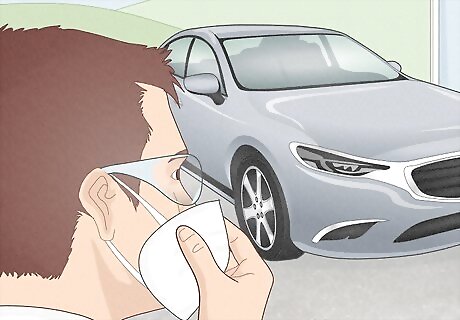
Work in a ventilated area and put on proper breathing and eye protection. Auto spray paints create a lot of unpleasant and potentially hazardous fumes, so always work in a well-ventilated area. In addition, be sure to put on a vapor mask or respirator mask—not just a dust mask—and goggles to protect your eyes. To make cleaning yourself up easier, wear long sleeves and disposable gloves. You can paint outdoors if it’s not too damp or humid and the temperature is between around 65–85 °F (18–29 °C). Avoid direct sunlight while painting. If you’re working in your garage, keep the main door and any other exterior doors and windows open. Set up one or more box fans to exhaust air and fumes out of the garage.
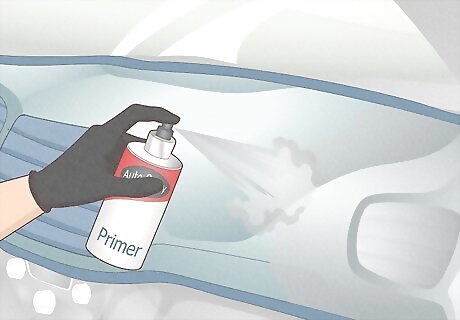
Apply a light, even coat of primer by using short, smooth, steady spray bursts. Shake the can for at least 1 minute, then hold it about 6–8 in (15–20 cm) from the surface you want to paint. Spray in about 1-second bursts, continually moving the can in a steady back-and-forth motion while spraying. Keep the coat light and even across all the surfaces you’re painting. Keep the can in motion whenever you’re spraying. Holding the can still over an area will create splotchy and runny patches of paint. If you’re unsure about your spraying technique, practice on scrap pieces of cardboard, wood, or—ideally—plastic or vinyl. The process is the same whether you’re using a filler primer or an adhesion promoter.
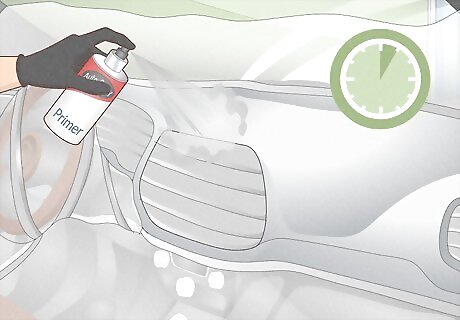
Wait 5-plus minutes, add another coat, and repeat 1-2 more times if desired. If the primer still looks damp at all, or if it’s a humid day, give it at least 15 minutes before continuing. Spray on the second coat of primer in the same way as the first, and wait another 5-plus minutes before adding a third coat. Always use at least 2 coats of primer, but opt for 3 or 4 total coats if possible. Applying several thin, even coats promotes better adhesion and durability. Shake the can for at least 1 minute before adding each subsequent coat. Use the same 5-plus minute waiting time throughout the process of priming, painting, and lacquering the dashboard. Make sure the final primer coat is completely dry before moving on to adding color coats. Wait 5 minutes at minimum, but preferably more like 15-60 minutes or longer.
Paint and Lacquer
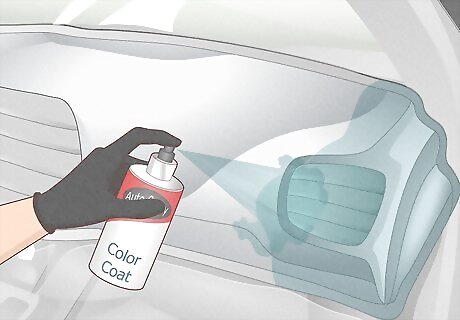
Apply a thin, even color coat layer, using the same spraying technique as before. Shake the can for at least 1 minute and hold it 6–8 in (15–20 cm) from the surface. Like with the primer, spray in quick bursts while using a steady back-and-forth motion. Make this first coat thin enough that you can still see the color of the primer underneath it.
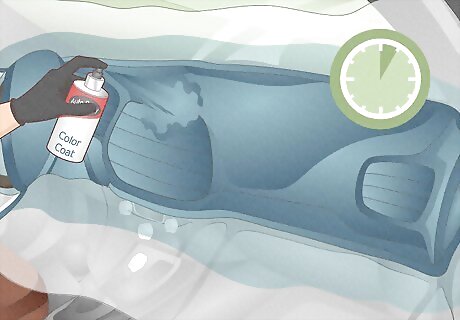
Add 3-8 total color coat layers, waiting at least 5 minutes between coats. Wait until the first coat looks dry before adding the second coat, once again using the same spraying process. Then keep repeating this procedure until you’ve added at least 3 color coats, but preferably more like 5-8. You’ll get diminishing returns after about 8 coats, but adding more coats generally enhances the look and durability of the paint job. Be patient while waiting for the paint to dry between coats. And don’t touch the paint to check it!
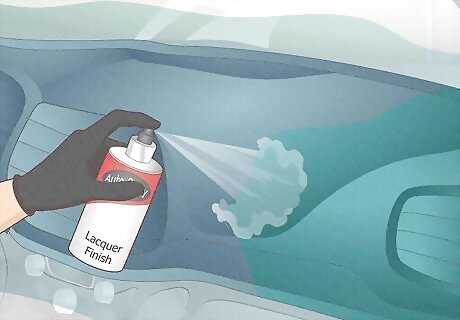
Spray on 3-4 lacquer coats with either a gloss or matte finish. While you can technically skip adding lacquer coats, doing so greatly increases the durability of your paint job and is highly recommended. Use the same spraying technique and waiting time as with the primer and color coats. Use a gloss lacquer if you want your dashboard to have a sheen, or a matte lacquer if you prefer a less shiny finish. Use a lacquer spray that’s intended for auto interiors.
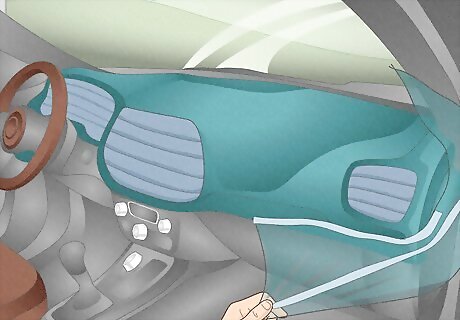
Wait 4+ hours before removing the tape and reinstalling any trim pieces. At bare minimum, give the final lacquer coat 4 hours to dry. If you can leave it overnight or a full 24 hours, all the better. Carefully peel away the painter’s tape and remove any plastic sheeting and craft paper. Reinstall any trim piece or panels you removed by popping them back into place. Then take a moment to admire your work! To maintain the durability of your paint job, clean the dashboard occasionally with nothing but a rag dampened with warm water and a small amount of dish soap.

















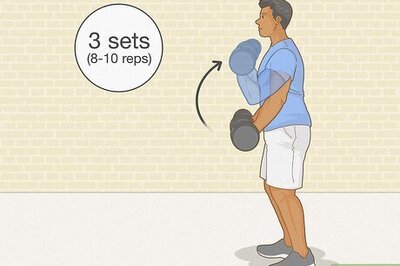

Comments
0 comment